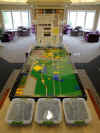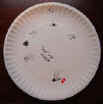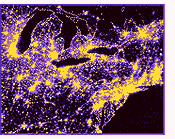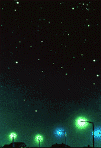Projects & Activities
|
Be a citizen-scientist by observing the sky for the Globe at Night star hunt and the Great World Wide Star Count. |
Let There Be Night
| Let There Be Night is a combined planetarium program and school district-wide experiment to assess a community's sky glow. Developed for IYA2009 with contributions from Toyota and other supporters, the experiment parallels the Globe at Night initiative. The planetarium program and DVD resources are available to prepare the teachers and students, who will assess sky glow from within the school district boundaries. See the Results from one community's vast experiment in 2009, in which teams of students made a 3-D model out of 35,000 LEGO blocks to convey visually how much of the local night sky has been lost to light pollution. | 
|
Night Vision
| Night Vision is a NASA-supported program in which observers quantify the sky glow over their community. Families and teams use hand-held Sky Quality Meters (SQMs) to measure the the amount of light reflected back down to earth from multiple sites. They will manually plot the SQM readings on a county map and create "contour lines" of equal brightness. The baseline map can be used in the future to suggest changes in the local light pollution level. After discussing the trade-offs of lighting technology and the social decisions related to outdoor lighting, participants will report their findings to the community through self-designed presentations. |
Sorry Starry Night
 |
For a science project named Sorry Starry Night, a student measured the sky glow from seven sites adjacent to a new retail development. From March to December, 2006, she plotted a downward slope of Sky Quality Meter (SQM) readings, which suggested the sky glow increased. The student attributed the increase to new lights from the development, additional reflectance from snow on the ground in the latter portion of the experiment, and holiday lights in the neighborhood. |
Paper Plate Education
How can you convey the impact of glare and the benefits of light shields? Try this simple experiment--so easy it was borrowed from an 8-year old. (Reproduced from Paper Plate Education, http://analyzer.depaul.edu/paperplate/lights.htm).
Here is another simple illustration--again borrowed from an 8-year old. (Reproduced from Paper Plate Education, http://analyzer.depaul.edu/paperplate/lights.htm).
Light Pollution Workshop:
workshop.htm
A light pollution workshop at a planetarium conference was dedicated to sharing techniques for
preserving the night sky. Many of the workshop activities, taken from the perspectives of varied
interest groups and stakeholders, can be
used by other dark sky advocates.
Other Projects:
 http://www.globe.gov/GaN/
http://www.globe.gov/GaN/
Globe at Night is a worldwide campaign to observe and record
the magnitude of visible stars as a means of measuring light pollution in
a given location. Website has an effective
simulator to show the limiting magnitudes of stars in the constellation
Orion.
 Extended
list of ideas for student
projects or academic fairs, with specific reference to issues in northern
Indiana.
Extended
list of ideas for student
projects or academic fairs, with specific reference to issues in northern
Indiana.
 http://www.darksky.org/programs/educational-outreach/
http://www.darksky.org/programs/educational-outreach/
Classroom activities and lesson plans listed by the International Dark-Sky
(IDA).
 http://www.sternhell.at/index.php
http://www.sternhell.at/index.php
Determine night sky visibility conditions by counting stars in Little Dipper and
Orion.
 www.nasa.gov/audience/foreducators/starcount
www.nasa.gov/audience/foreducators/starcount
Participate in a star count performed by Canadian Space Agency astronaut Steve
MacLean aboard the Space Shuttle Atlantis in September 2006.
"Students
will learn how to estimate the number of stars observed based
on random samples of sections of the sky. Students will add to the
database by entering their location, number of stars observed and information
about their viewing conditions. The students will be able to
compare their observations with MacLean's and other observers."
 http://www.starcount.org/
http://www.starcount.org/
International event encourages everyone to go outside, look skywards after dark,
count the stars they see in certain constellations, and report what they see
online.
gsms.html
Two students measure sky glow in their community, then share results with
their classmates in a portable planetarium.
 http://www.islandastro.org/mdilightpollution.html
http://www.islandastro.org/mdilightpollution.html
"The first light pollution map of Mount Desert Island
was created by College of the Atlantic students...as part of the Island
Astronomy Institute’s new Starlit Communities Project. They gathered 140
data points over two moonless nights this April. The
map documents loss of natural starlight caused by artificial sky glow."
rockland.htm
Students of the Applied Democracy class at Watershed
Community School in Rockland, Maine used an SQM and a handheld GPS to map
sky glow in their town.
 jefferson2.jpg
jefferson2.jpg
Students plot SQM values by hand on a map.
 http://www.novac.com/lp/lpe.php
http://www.novac.com/lp/lpe.php
The Northern Virginia Astronomers Club (Novac) proposes to extend its earlier
start counts, then known as Project Orion, with the Next Generation Light
Pollution Map.
 http://media.skytonight.com/documents/200704042045.pdf
http://media.skytonight.com/documents/200704042045.pdf
Count Light Pollution Out by Sky & Telescope contributing editor Fred
Schaaf advocates large-scale star counts; pp. 42-47, April, 2007.
 http://www.astrosociety.org/education/publications/tnl/44/lightpoll.html
http://www.astrosociety.org/education/publications/tnl/44/lightpoll.html
Light Pollution, Universe in the Classroom, No. 44, Fall 1998; from the
Astronomical Society of the Pacific.
 http://www.nsta.org/programs/laptop/lessons/m4.htm
http://www.nsta.org/programs/laptop/lessons/m4.htm
At Issue: Light Pollution by Mary Lightbody.
 http://www.darksky.org/infoshts/is113.html
http://www.darksky.org/infoshts/is113.html
Count the Stars! An Activity for Elementary Students, Grades 4-6;
International Dark-Sky Association, Information Sheet 113.
 http://www.redshiftnow.ca/starwatch/default.aspx
http://www.redshiftnow.ca/starwatch/default.aspx
Star Watch measures the sky brightness over Canada by counting the stars
of the Little Dipper in Ursa Minor; from the Ontario Science Centre.
 http://www.plugged-in.org/counting_stars.html http://www.plugged-in.org/counting_stars.htmlGirl Scouts count stars to determine limiting magnitude of their sky.
|
 chain
chain
Energy chain illustrates
how only about 1% of initial energy makes it from generator to roadway
reflection.
 http://britastro.org/dark-skies/education.html?2O
http://britastro.org/dark-skies/education.html?2O
Pupil dilation experiments demonstrate the effects of light pollution; from
the Campaign for Dark Skies.











